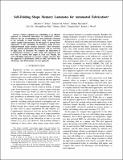| dc.contributor.author | Tolley, Michael T. | |
| dc.contributor.author | Felton, Samuel M. | |
| dc.contributor.author | Miyashita, Shuhei | |
| dc.contributor.author | Xu, Lily | |
| dc.contributor.author | ByungHyun Shin, Lily | |
| dc.contributor.author | Zhou, Monica | |
| dc.contributor.author | Wood, Robert J. | |
| dc.contributor.author | Rus, Daniela L. | |
| dc.date.accessioned | 2014-10-09T18:14:09Z | |
| dc.date.available | 2014-10-09T18:14:09Z | |
| dc.date.issued | 2013-11 | |
| dc.identifier.isbn | 978-1-4673-6358-7 | |
| dc.identifier.isbn | 978-1-4673-6357-0 | |
| dc.identifier.issn | 2153-0858 | |
| dc.identifier.uri | http://hdl.handle.net/1721.1/90845 | |
| dc.description.abstract | Nature regularly uses self-folding as an efficient approach to automated fabrication. In engineered systems, however, the use of self-folding has been primarily restricted to the assembly of small structures using exotic materials and/or complex infrastructures. In this paper we present three approaches to the self-folding of structures using low-cost, rapid-prototyped shape memory laminates. These structures require minimal deployment infrastructure, and are activated by light, heat, or electricity. We compare the fabrication of a fundamental structure (a cube) using each approach, and test ways to control fold angles in each case. Finally, for each self-folding approach we present a unique structure that the approach is particularly suited to fold, and discuss the advantages and disadvantages of each approach. | en_US |
| dc.description.sponsorship | National Science Foundation (U.S.) (Award CCF-1138967) | en_US |
| dc.description.sponsorship | National Science Foundation (U.S.) (Award EFRI-1240383) | en_US |
| dc.language.iso | en_US | |
| dc.publisher | Institute of Electrical and Electronics Engineers (IEEE) | en_US |
| dc.relation.isversionof | http://dx.doi.org/10.1109/IROS.2013.6697068 | en_US |
| dc.rights | Creative Commons Attribution-Noncommercial-Share Alike | en_US |
| dc.rights.uri | http://creativecommons.org/licenses/by-nc-sa/4.0/ | en_US |
| dc.source | Other univ. web domain | en_US |
| dc.title | Self-folding shape memory laminates for automated fabrication | en_US |
| dc.type | Article | en_US |
| dc.identifier.citation | Tolley, Michael T., Samuel M. Felton, Shuhei Miyashita, Lily Xu, ByungHyun Shin, Monica Zhou, Daniela Rus, and Robert J. Wood. “Self-Folding Shape Memory Laminates for Automated Fabrication.” 2013 IEEE/RSJ International Conference on Intelligent Robots and Systems (November 2013). | en_US |
| dc.contributor.department | Massachusetts Institute of Technology. Computer Science and Artificial Intelligence Laboratory | en_US |
| dc.contributor.department | Massachusetts Institute of Technology. School of Engineering | en_US |
| dc.contributor.mitauthor | Miyashita, Shuhei | en_US |
| dc.contributor.mitauthor | Rus, Daniela L. | en_US |
| dc.relation.journal | Proceedings of the 2013 IEEE/RSJ International Conference on Intelligent Robots and Systems | en_US |
| dc.eprint.version | Author's final manuscript | en_US |
| dc.type.uri | http://purl.org/eprint/type/ConferencePaper | en_US |
| eprint.status | http://purl.org/eprint/status/NonPeerReviewed | en_US |
| dspace.orderedauthors | Tolley, Michael T.; Felton, Samuel M.; Miyashita, Shuhei; Xu, Lily; ByungHyun Shin, Lily; Zhou, Monica; Rus, Daniela; Wood, Robert J. | en_US |
| dc.identifier.orcid | https://orcid.org/0000-0001-5473-3566 | |
| dc.identifier.orcid | https://orcid.org/0000-0002-6602-5329 | |
| mit.license | OPEN_ACCESS_POLICY | en_US |
| mit.metadata.status | Complete | |
